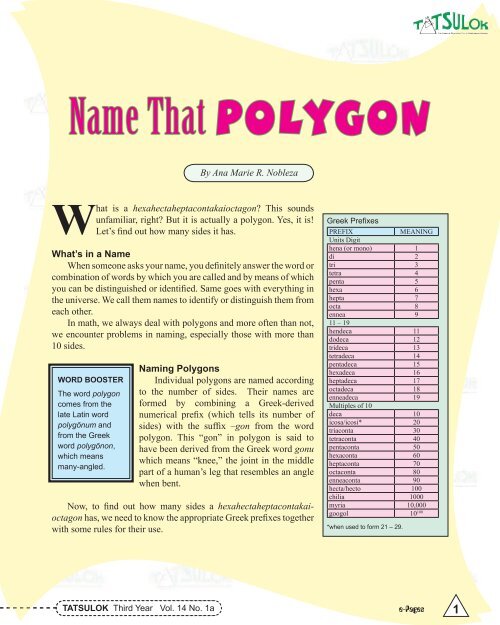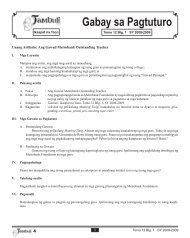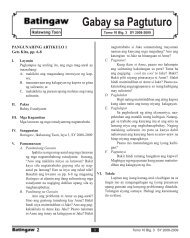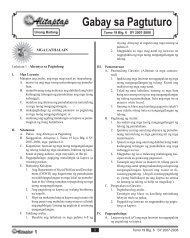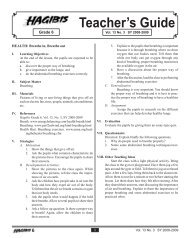Name That Polygon
Name That Polygon
Name That Polygon
Create successful ePaper yourself
Turn your PDF publications into a flip-book with our unique Google optimized e-Paper software.
<strong>Name</strong> <strong>That</strong> <strong>Polygon</strong><br />
What is a hexahectaheptacontakaioctagon? This sounds<br />
unfamiliar, right? But it is actually a polygon. Yes, it is!<br />
Let’s find out how many sides it has.<br />
What’s in a <strong>Name</strong><br />
When someone asks your name, you definitely answer the word or<br />
combination of words by which you are called and by means of which<br />
you can be distinguished or identified. Same goes with everything in<br />
the universe. We call them names to identify or distinguish them from<br />
each other.<br />
In math, we always deal with polygons and more often than not,<br />
we encounter problems in naming, especially those with more than<br />
10 sides.<br />
WORD BOOSTER<br />
The word polygon<br />
comes from the<br />
late Latin word<br />
polygōnum and<br />
from the Greek<br />
word polygōnon,<br />
which means<br />
many-angled.<br />
By Ana Marie R. Nobleza<br />
Naming <strong>Polygon</strong>s<br />
Individual polygons are named according<br />
to the number of sides. Their names are<br />
formed by combining a Greek-derived<br />
numerical prefix (which tells its number of<br />
sides) with the suffix –gon from the word<br />
polygon. This “gon” in polygon is said to<br />
have been derived from the Greek word gonu<br />
which means “knee,” the joint in the middle<br />
part of a human’s leg that resembles an angle<br />
when bent.<br />
Now, to find out how many sides a hexahectaheptacontakaioctagon<br />
has, we need to know the appropriate Greek prefixes together<br />
with some rules for their use.<br />
Greek Prefixes<br />
PREFIX<br />
Units Digit<br />
MEANING<br />
hena (or mono) 1<br />
di 2<br />
tri 3<br />
tetra 4<br />
penta 5<br />
hexa 6<br />
hepta 7<br />
octa 8<br />
ennea<br />
11 – 19<br />
9<br />
hendeca 11<br />
dodeca 12<br />
trideca 13<br />
tetradeca 14<br />
pentadeca 15<br />
hexadeca 16<br />
heptadeca 17<br />
octadeca 18<br />
enneadeca<br />
Multiples of 10<br />
19<br />
deca 10<br />
icosa/icosi* 20<br />
triaconta 30<br />
tetraconta 40<br />
pentaconta 50<br />
hexaconta 60<br />
heptaconta 70<br />
octaconta 80<br />
enneaconta 90<br />
hecta/hecto 100<br />
chilia 1000<br />
myria 10,000<br />
googol 10100 *when used to form 21 – 29.<br />
TATSULOK Third First Year Vol. 12 14 No. 1a e-Pages e-Pages 1
RULES IN FORMING NUMERICAL PREFIXES<br />
For polygons with: Form numerical prefix by:<br />
10 sides or less and multiples of 10 simply copy the prefixes for the units digit<br />
11 – 19 sides* combine: units digit + kai **+ deca<br />
21 – 99 combining:<br />
tens digit and units digit<br />
multiples of 10 from<br />
the table<br />
In Euclidean Geometry, the least number of sides for<br />
polygons is three. Thus, from the rules and prefixes above, we<br />
form the polygon with the least number of sides by combining<br />
tri and gon to have trigon. This polygon is what we commonly<br />
know as the triangle. The tetragon or the four-sided polygon is<br />
what we familiarly call quadrilateral.<br />
To construct the names of the polygons in the exercises, it<br />
would be helpful to write the number of sides in expanded form<br />
and then find the equivalent prefixes for each number.<br />
kai units digit from the<br />
table<br />
101 – 999 combining:<br />
hundreds digit tens digit and units digit<br />
units digit<br />
from the table<br />
+ “hecta”<br />
multiples of<br />
10 from the<br />
table<br />
a. 26-sided = 20 and (+) 6<br />
icosi kai hexa gon<br />
= icosikaihexagon (sometimes named icosihexagon)<br />
b. 45-sided = 40 + 5<br />
tetraconta kai penta gon<br />
= tetracontakaipentagon (sometimes tetracontapentagon)<br />
c. 102-sided = 100 + 0 + 2<br />
hecta kai di gon<br />
= hectakaidigon<br />
d. 400-sided = 400 + 0 + 0<br />
tetrahecta gon<br />
= tetrahectagon<br />
e. 678-sided = 600 + 70 + 8<br />
hexahecta heptaconta kai octa gon<br />
= hexahectaheptacontakaioctagon<br />
kai units digit<br />
from the table<br />
* the word “kai” is often omitted for these numbers (see table for 11 – 19 at the right)<br />
** the word kai is a Greek word that stands for “and” and is used before the prefix for the units digit<br />
Challenge!<br />
<strong>Name</strong> the following polygons:<br />
(a) 26-sided polygon<br />
(b) 45-sided polygon<br />
(c) 102-sided polygon<br />
(d) 400-sided polygon<br />
(e) 678-sided polygon<br />
TATSULOK Third First Year Vol. 12 14 No. 1a e-Pages e-Pages 2
So how many sides does a hexahectaheptacontakaioctagon have? Doing the same procedure,<br />
we see that it has 678 sides.<br />
Take note that when you see the word hecta in a name, that means you are in the hundreds place,<br />
conta in the tens (30 - 90) place, and the kai in the ones place. However, sometimes the word kai<br />
is already omitted, just like in the names of polygons with 11 to 19 sides. For instance, to tell how<br />
many sides a heptahectaheptacontaheptagon has, we need to work backward—hepta before gon<br />
means 7, heptaconta means 70, and heptahecta means 700. Thus, the polygon has 777 sides.<br />
Wow! What a name! Did the process confuse you? You probably just need practice in applying<br />
the rules. But don’t worry, because as long as you understand what you are referring to when you say<br />
the name, that is all that matters. These days, professional mathematicians consider even prefixing<br />
the word “gon” with the number of sides (n-gons) for polygons beyond enneagons and decagons.<br />
TATSULOK Third First Year Vol. 12 14 No. 1a e-Pages<br />
3
MORE OR LESS?<br />
Matt and Geo is playing the more or less game but this time with the number of sides of polygons.<br />
Each of them writes fi ve polygons on a piece of paper. Your task now is to decide who wins between<br />
the two Matt and Geo.<br />
Matt’s List<br />
1. icosikaienneagon<br />
2. pentakaidecagon<br />
3. hectaenneacontakaitrigon<br />
4. octahectapentacontahenagon<br />
5. tetrahectohexagon<br />
Geo’s List<br />
1. tetracontakaidigon<br />
2. pentadecagon<br />
3. dihectagon<br />
4. heptahectahexacontakaidigon<br />
5. pentahectopentacontagon<br />
TATSULOK Third First Year Year Vol. Vol. 12 14 No. No. 1a 1a e-Pages 4
WORKSHEET<br />
A. Connect the polygons from the least to the greatest number of sides then back to the least. What<br />
kind of polygon is inscribed?<br />
B. <strong>Name</strong> the following polygons.<br />
1. 111-sided<br />
2. 222-sided<br />
3. 333-sided<br />
4. 444-sided<br />
5. 555-sided<br />
6. 666-sided<br />
7. 777-sided<br />
8. 888-sided<br />
9. 999-sided<br />
10. 10 100-sided<br />
TATSULOK Third First Year Year Vol. Vol. 12 14 No. No. 1a 1a e-Pages 5<br />
5
Answer to Activity<br />
Matt’s list Geo’s list<br />
icosikaienneagon (29) < tetracontakaidigon (42)<br />
pentakaidecagon (15) = pentadecagon (15)<br />
hectaenneacontakaitrigon (193) < dihectagon (200)<br />
octahectapentacontahenagon (851) > heptahectahexacontakaidigon (762)<br />
tetrahectohexagon (406) < pentahectopentacontagon (550)<br />
Geo wins!<br />
Answer to Worksheet<br />
A. The inscribed polygon is 18-sided or octadecagon.<br />
B.<br />
1. hectahendecagon<br />
2. dihectaicosikaidigon<br />
3. trihectatricontakaitrigon<br />
4. tetrahectatetracontakaitrigon<br />
5. pentahectapentacontakaipentagon or pentahectapentacontapentagon<br />
6. hexahectahexacontakaihexagon or hexahectahexacontahexagon<br />
7. heptahectaheptacontakaiheptagon or heptahectaheptacontaheptagon<br />
8. octahectaoctacontakaioctagon or octahectaoctacontaoctagon<br />
9. enneahectaenneacontakaienneagon or enneahectaenneacontaenneagon<br />
10. googolgon<br />
TATSULOK Third First Year Vol. 12 14 No. 1a e-Pages 6


